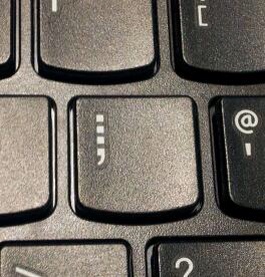Every time I finish one of these posts, the blog quickly recedes into the back of my mind. The beast has been fed, and I can relax. The time of writing is a small part of the challenge; mainly I’m struggling with topics that mean something to me and might have value to a few people who read. Today I have a very short post with a single idea.
It’s time to re-engineer the keyboard to reflect the realities of modern writing. On a traditional keyboard we need to flip the semicolon/colon key. Currently the default is semicolon, and one must hit the caps key to add a colon. Even as one of the few people who still knows how to use a semicolon correctly, I notice that I use it far, far less than the colon. Modern digital conventions have brought the colon into a prominence it didn’t possess at the dawning of the keyboard. Too often in proofreading I find semicolons in the middle of colon-requiring expressions (or worse, I don’t find them).
Now, I anticipate the response to such a move would be general protest from touch-typists worldwide. I acknowledge that I remain a fast two-to-five finger typist, so probably this is a greater problem for me; however, (correct use of semicolon) I wonder whether decisions on the best format of the keyboard should be dictated by past users or potential future ones. Do we tie into a system forever because this is what we have always done, even if textual realities (and devices) have changed?
I see another example of this on my iPad keyboard. One of my greatest gripes with the onboard keyboard is the lack of a delete key. Deletion always has to be done through the backspace, which doesn’t always best meet my needs. I know that the virtual keypad is built to resemble a traditional keyboard as much as possible, but why couldn’t one shift key be replaced with a delete key? A user already has to manipulate the different keyboards for letters, numbers, and symbols, so learning another convention wouldn’t seem too hard (they could even have left and right settings for the shift for user preference).
There is no mention of keyboards being given to humans by God in sacred scripture (unless I missed something). With the advent and growth of the virtual keyboard, let’s make a better one.
As always, I welcome your ideas.

An excellent post. It took me many years to learn how to use a semicolon correctly. I know that one can easily remap the keys on a keyboard to accomplish what you are talking about, however I wonder if the iPad or other tablets allow this key-mapping ability (my gut says they probably do not).
I’ve often played with the idea of trying to switch from the standard qwerty keyboard layout to something with more efficiency such as Dvorak. However I have years of working with the rather antediluvian qwerty and I tend to stick with it rather than jump into the uncomfortable realm of re-learning how to touch type in a new way.
One day I think I’ll take on the Dvorak challenge, however it may be quite a while before I brave those waters.
I agree about the delete key.